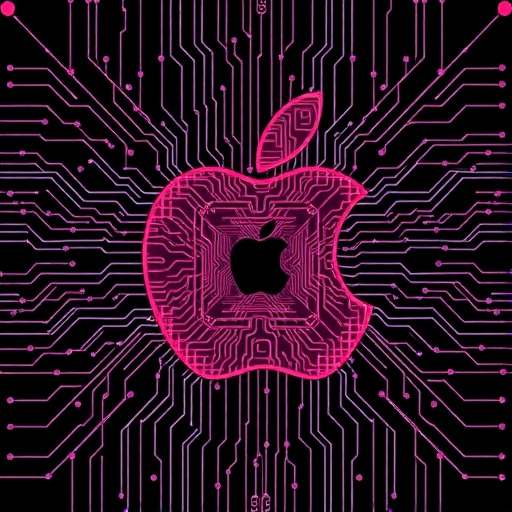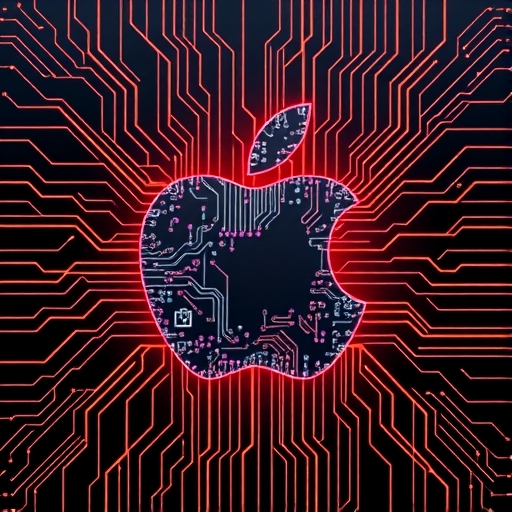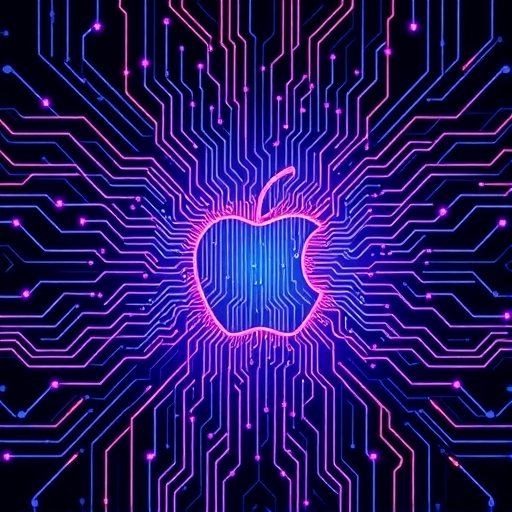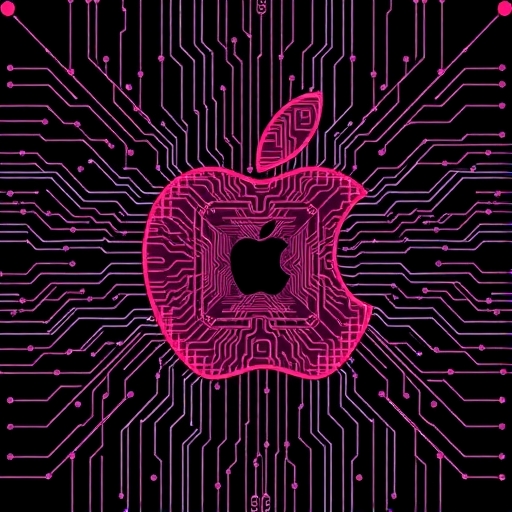Unveiling Apple’s AI Strategy: Insights from the Financial Times and Pitchbook Data
Apple is reportedly accelerating its push into Artificial Intelligence, a strategic move largely conducted away from the public spotlight compared to its Big Tech rivals. Leveraging insights from sources like the Financial Times and detailed data from Pitchbook, we can begin to piece together the contours of Apple’s unique AI strategy, its significant investment in acquisitions, and the potential impact on its future products, services revenue, and market valuation. This isn’t just about catching up; it’s about integrating AI in a way that aligns with Apple’s core philosophy and vast ecosystem.
- Apple focuses on embedding AI across its products rather than solely developing chatbots.
- Investment in AI is expected to exceed $1 billion annually.
- The company has acquired numerous AI firms to enhance its technology and talent pool.

The Core Strategy: Embedding AI, Not Just Building Chatbots
When you hear about the “AI arms race,” your mind might immediately jump to large language models (LLMs) powering conversational chatbots like OpenAI’s ChatGPT, Google’s Bard, or Microsoft’s Bing AI. Companies like Microsoft and Google have made very public spectacles of their generative AI advancements. Apple, however, has taken a notably different path, one that CEO Tim Cook has often described as focusing on Machine Learning (ML) and AI as fundamental technologies embedded across virtually all of their products and services.
This distinction is critical. While rivals trumpet their standalone generative AI models, Apple’s emphasis has been on baking sophisticated ML capabilities directly into the user experience, often without the user even realizing it’s AI at work. Think of features like the intelligent processing of photos, the predictive text on your keyboard, the health insights from your Apple Watch, or the spatial awareness powered by ML in the Vision Pro. These are powerful AI applications, but they typically operate quietly on-device, prioritizing user privacy and seamless integration over public-facing conversational AI.
This strategic choice reflects Apple’s historical approach to technology adoption – they often wait, observe, and then integrate new paradigms in a way that feels natural and intuitive within their tightly controlled ecosystem. It’s less about being first and more about being perceived as integrating the technology “right” for their users. Yet, the increasing prominence of generative AI is undeniable, and it’s prompting Apple to evolve its strategy, reportedly allocating substantial resources to catch up in areas where it might be perceived as lagging.
| Aspect | Apple’s Approach |
|---|---|
| Focus | Embedding AI in products |
| Investment | Over $1 billion annually |
| Acquisitions | Numerous AI startups |
Investment Footprint: Following the Money Trail (> $1 Billion?)
While Apple doesn’t break out specific R&D spending figures purely for AI, reports suggest the company is investing heavily in the field. Some estimates, like those cited by analysts, place Apple’s annual AI-related investment at or even exceeding $1 billion. However, given the pervasive nature of ML and AI within Apple’s R&D – remember Tim Cook’s statement that these are fundamental to *all* products – the true figure is likely significantly higher when you consider the myriad engineering teams incorporating AI/ML across hardware, software, and services.
This investment isn’t just passive spending; it’s directed towards research, talent acquisition, infrastructure development (like powerful chips optimized for ML tasks), and critically, the acquisition of smaller AI companies. The scale and nature of this investment underscore the strategic importance Apple places on AI, viewing it not as a feature but as the underlying fabric of future innovation. This heavy financial commitment signals a long-term play, building the foundational capabilities necessary to compete in an increasingly AI-driven world.
Understanding the true scope of this investment requires looking beyond simple dollar figures and considering the strategic allocation of resources towards building on-device processing capabilities, developing proprietary models, and integrating AI deeply into the core operating systems and applications that billions of people use daily. It’s an investment in seamless intelligence, designed to enhance the user experience without demanding explicit interaction with an AI agent.
The Acquisition Engine: Pitchbook Data Reveals the Pace
Perhaps one of the most telling indicators of Apple’s aggressive, albeit quiet, push into AI comes from its acquisition strategy. Data compiled by firms like Pitchbook provides valuable insight into the pace and volume of Apple’s M&A activity specifically within the AI sector. While other Big Tech firms have also been active buyers, Pitchbook data has consistently highlighted Apple as one of the most prolific acquirers of AI companies over recent years.
According to Pitchbook figures cited in financial reports, Apple has acquired dozens of AI-focused companies in the past 7-8 years – estimates vary but often place the number between 21 and upwards of 30. This volume often surpasses that of rivals like Google, Microsoft, or Meta over similar periods, depending on how acquisitions are categorized. While many of these deals are relatively small compared to multi-billion dollar acquisitions seen elsewhere, their sheer number paints a clear picture: Apple is systematically buying up AI talent, technology, and intellectual property.

These acquisitions rarely make headlines. Apple typically folds these startups and their teams into its existing engineering divisions, leveraging their expertise or specific technologies to enhance its own projects. Unlike splashy acquisitions aimed at immediate market positioning, Apple’s AI M&A appears designed for incremental, strategic integration into future products and services. Pitchbook’s data provides the quantitative evidence behind Apple’s qualitative statements about the importance of AI – they are backing up their words with numerous targeted acquisitions.
Why Acquisitions? Talent, Tech, and Strategic Integration
So, why this heavy reliance on acquisitions, particularly as revealed by Pitchbook data? The answer lies in a combination of factors crucial to Apple’s strategy. Firstly, it’s about acquiring top-tier talent. The AI field is fiercely competitive for skilled researchers and engineers. Buying a startup is often the most effective way to bring cohesive, experienced teams with specialized knowledge in areas like natural language processing, computer vision, or machine learning infrastructure under Apple’s roof.
Secondly, it’s about technology and intellectual property. Smaller AI companies often develop innovative algorithms, datasets, or platform components that can accelerate Apple’s own internal development efforts. Instead of building everything from scratch, acquiring proven technology allows Apple to integrate capabilities faster and potentially leapfrog certain development hurdles. This is particularly important in rapidly evolving areas like generative models or on-device AI processing.
Finally, it’s about strategic integration. Each acquisition fills a specific piece of Apple’s larger AI puzzle. Whether it’s a company specializing in efficient on-device ML models, personalized AI experiences, or foundational AI research, these smaller pieces are integrated into Apple’s vast ecosystem, contributing to the overall intelligence of the platform. This piecemeal approach, revealed by the volume in Pitchbook data, allows Apple to build its AI capabilities methodically and strategically, rather than relying on a single, large bet.
Consider the complexity of integrating AI into billions of devices with varying hardware capabilities while maintaining strict privacy standards. Acquiring companies with expertise in efficient model deployment, federated learning, or secure on-device AI is invaluable for tackling these specific challenges. It’s a testament to Apple’s long-term vision for embedding intelligence everywhere, fueled by targeted acquisitions.
AI Already Here: ML in Today’s Apple Products
While the focus is often on what’s coming next, it’s important to recognize that AI and ML are already deeply embedded in the Apple devices you use every day. These aren’t always flashy “AI features” in the generative sense, but powerful applications of machine learning that enhance functionality and user experience.
Take the iPhone 15’s camera, for instance. Features like Deep Fusion and the Photonic Engine use computational photography powered by ML to optimize image quality, even in challenging lighting conditions. The neural engine on Apple silicon chips is specifically designed to accelerate these ML tasks on-device. Features like Live Voicemail in iOS use on-device ML to provide real-time transcriptions. Siri, Apple’s long-standing virtual assistant, relies heavily on natural language processing and ML, although it faces its own challenges in the age of more capable conversational AIs.
Beyond the iPhone, the Apple Watch uses ML to analyze health data and detect anomalies, contributing to features like fall detection and activity tracking. The Vision Pro, Apple’s spatial computing headset, relies on complex ML algorithms for tracking hand movements, understanding the environment, and rendering spatial experiences. Even seemingly simple features like battery optimization or predictive text on the keyboard leverage underlying ML models that learn from your usage patterns.

These examples demonstrate Apple’s proficiency in applying ML to solve practical user problems and enhance device capabilities. While the public eye might be fixed on generative AI, Apple has been quietly building a sophisticated on-device ML infrastructure that serves as a powerful foundation for future AI advancements.
Anticipating the Future: AI Features in Upcoming iPhones (2024-2025)
The market’s attention is increasingly turning towards the next generation of iPhones, specifically the models expected in late 2024 and 2025, which are widely anticipated to feature significant new AI capabilities. Reports suggest these updates will go beyond the current embedded ML and integrate more advanced AI, potentially including aspects of generative AI, into core iOS functions and apps.
Analysts, including those like Daniel Ives at Wedbush Securities, have pointed to these expected AI features as a key driver for a potential “supercycle” of iPhone upgrades. After years of iterative improvements, major AI advancements could provide a compelling reason for users to upgrade their devices. Bank of America analysts, among others, have also cited future AI capabilities as a factor in their optimistic outlooks and stock upgrades for Apple, as reported by the Financial Times.
What might these features look like? While Apple remains tight-lipped, speculation centers on enhanced Siri capabilities powered by larger language models, more sophisticated photo and video editing tools using generative AI, AI-driven summarization features within apps, and potentially deeper integration of AI into productivity and creativity workflows. The focus is expected to remain on integrating these features seamlessly into the existing Apple experience, likely emphasizing on-device processing for privacy and speed where possible, complemented by cloud-based AI for more intensive tasks.
The success of these upcoming AI features will be a critical test for Apple’s strategy. Can they deliver AI experiences that feel genuinely innovative and valuable to users, leveraging their existing strengths while addressing the capabilities users are now coming to expect from generative AI?
Market Reaction & Analyst Views: Stock Impact and Expectations (FT Reporting)
Apple’s relatively quiet approach to AI, particularly compared to the public fanfare surrounding generative AI from rivals, has led to mixed market reactions and analyst views. For a period, some critics and investors expressed concern that Apple was “far behind” in the AI race, specifically in the area of large language models and generative AI.
However, as reports of Apple’s significant internal investments and extensive acquisition strategy (as highlighted by Pitchbook data) have surfaced, coupled with anticipation for future product launches, the narrative has begun to shift. The Financial Times and other financial news outlets have reported on analysts increasingly factoring Apple’s potential AI advancements into their valuations.
Analysts like Daniel Ives have remained bullish, arguing that Apple’s strength lies not just in AI research but in its unparalleled ecosystem and massive installed base, which provide a unique platform for deploying and monetizing AI features. Others, such as Laura Martin at Needham, have highlighted Apple’s potential to become a dominant player in distributing AI applications through its App Store, akin to how it dominates mobile app distribution today.
The recent stock upgrades from firms like Bank of America, partly attributed to future AI capabilities, signal growing confidence that Apple’s strategic, embedded AI approach, combined with upcoming feature rollouts, will translate into tangible product advantages and revenue growth. While the debate about who “leads” in the AI arms race continues, the market appears to be increasingly recognizing the long-term potential of Apple’s distinctive strategy.
The Ecosystem Advantage: Leveraging the Two Billion Users
One of Apple’s most significant assets in the AI race, arguably more impactful than any single generative model, is its massive installed base. With over two billion active iOS devices worldwide, Apple has a direct line to a colossal user population ready to potentially benefit from and engage with new AI features. This scale provides an unparalleled platform for rolling out AI capabilities, gathering user feedback (anonymously and with permission, aligned with Apple’s privacy principles), and driving adoption.
This vast ecosystem isn’t just about numbers; it’s about integration. Apple controls the hardware, the operating system, and often the key applications users interact with daily. This vertical integration allows Apple to optimize AI models and features specifically for its devices and software environment, potentially leading to more efficient, faster, and more private on-device AI experiences compared to platforms running AI on a multitude of different hardware configurations.
For developers, this ecosystem represents a massive potential market for AI-powered applications. Apple’s tools and frameworks for integrating ML into apps (like Core ML) make it easier for developers to leverage the neural engine on Apple silicon. As Apple introduces more sophisticated AI capabilities into iOS, the potential for developers to create innovative AI-driven experiences within the Apple ecosystem grows exponentially.
This installed base is a powerful network effect. New AI features integrated into iOS automatically become available to hundreds of millions of users, driving engagement and creating opportunities for further innovation based on how users interact with these features. It’s a built-in advantage that rivals, despite their AI prowess, cannot easily replicate.
Monetization Potential: The ‘AI App Store’ and Services Growth
Beyond driving hardware upgrades, AI presents significant opportunities for Apple’s booming services business. Analysts, including Daniel Ives, have speculated about the potential for Apple to create an “AI App Store” or similar mechanism to monetize advanced AI features and applications within its ecosystem.
Imagine a future where developers can build sophisticated AI models or applications (perhaps specialized generative AI tools, advanced creative filters, hyper-personalized productivity assistants) that run on Apple devices or leverage Apple’s cloud infrastructure. Apple could take a cut of transactions or subscriptions associated with these AI services, similar to its highly successful model with the traditional App Store. This could unlock a massive new revenue stream, adding further fuel to the growth of the services segment, which is already a major driver of Apple’s profitability.
Furthermore, AI can enhance existing services. AI can improve Apple Music recommendations, personalize Apple News feeds, make iCloud storage more intelligent, and enhance features within Apple Fitness+ or Apple Arcade. Each of these improvements, powered by AI, makes the services ecosystem more sticky and valuable to users, potentially increasing subscription rates and engagement.
While details remain speculative, the idea of Apple leveraging its platform control and installed base to become a major distribution channel for AI-powered services and applications is a compelling one with significant monetization potential. It aligns perfectly with Apple’s strategy of building powerful, integrated experiences that drive both hardware sales and recurring services revenue.
AI in the Broader Market: Pitchbook’s Take on VC Trends
Understanding Apple’s AI strategy also requires considering the broader market context, and here, data from Pitchbook provides valuable insights into Venture Capital (VC) trends influenced by AI and other factors. Pitchbook reports on overall investment patterns reveal that while AI is driving significant interest and capital, the investment landscape is becoming more complex and discerning.
Pitchbook data suggests increased scrutiny on deals, driven partly by the uncertainties surrounding the long-term profitability and practical use cases for some of the most hyped AI technologies, particularly standalone generative AI. Investors are looking for clearer paths to revenue and sustainable business models beyond initial excitement. The data also highlights rising hurdles for broad AI adoption, including the need for specific technical skills, the high cost of implementation (especially for large models), and defining clear, valuable use cases for businesses and consumers alike.
However, within this complex landscape, Pitchbook data indicates that certain sectors, like fintech, continue to attract significant growth capital, even amidst tighter overall funding environments. This suggests that while the AI transition is influencing investment decisions globally, established sectors with clear digital transformation needs remain attractive.
This broader VC context from Pitchbook provides a backdrop for understanding Apple’s strategic patience. In a market grappling with the practicalities and monetization of cutting-edge AI, Apple’s focus on integrating proven ML capabilities and building a robust on-device infrastructure appears less like hesitation and more like a deliberate, lower-risk approach to riding the AI wave. They are building the engine within their existing successful business model, rather than solely betting on the nascent and still-evolving generative AI application layer.
Conclusion: Apple’s Long-Term AI Vision
While Apple has taken a distinct, often understated path in the AI race, its substantial investments, strategic acquisitions highlighted by Pitchbook data, and deep integration of machine learning across its vast ecosystem position it as a significant long-term player. Unlike rivals chasing public attention with headline-grabbing generative AI models, Apple has been focused on building a foundation of pervasive, on-device AI designed to enhance every aspect of the user experience while prioritizing privacy.
The anticipation surrounding new AI features in upcoming iPhones, reported on by outlets like the Financial Times and factored into analyst upgrades, underscores the market’s belief that Apple’s quiet strategy is poised to yield tangible results. Leveraging its unparalleled installed base of over two billion users, Apple is uniquely positioned to deploy AI features at scale and potentially create powerful new monetization opportunities through its services business, perhaps even via a future “AI App Store.”
The success of Apple’s AI strategy will hinge on its ability to translate its deep investments and technological prowess into user-facing features that are both innovative and seamlessly integrated. As the AI landscape continues to evolve, informed by broader VC trends highlighted by Pitchbook data and the competitive dynamics among tech giants, Apple’s strategic patience and focus on embedding intelligence across its ecosystem may prove to be a powerful and sustainable approach to maintaining its leadership in the decade ahead.
apple ai pitchbook apple financialtimesFAQ
Q:What is Apple’s main focus in AI development?
A:Apple focuses on embedding AI directly into its products and services, enhancing user experience through machine learning without making it overtly visible to users.
Q:How much is Apple investing in AI annually?
A:Apple’s annual investment in AI is reportedly over $1 billion, accounting for extensive R&D across various teams.
Q:Why is Apple acquiring so many AI companies?
A:Apple acquires AI companies to secure top talent, integrate advanced technologies, and ensure strategic enhancements in AI capabilities across its ecosystem.

留言